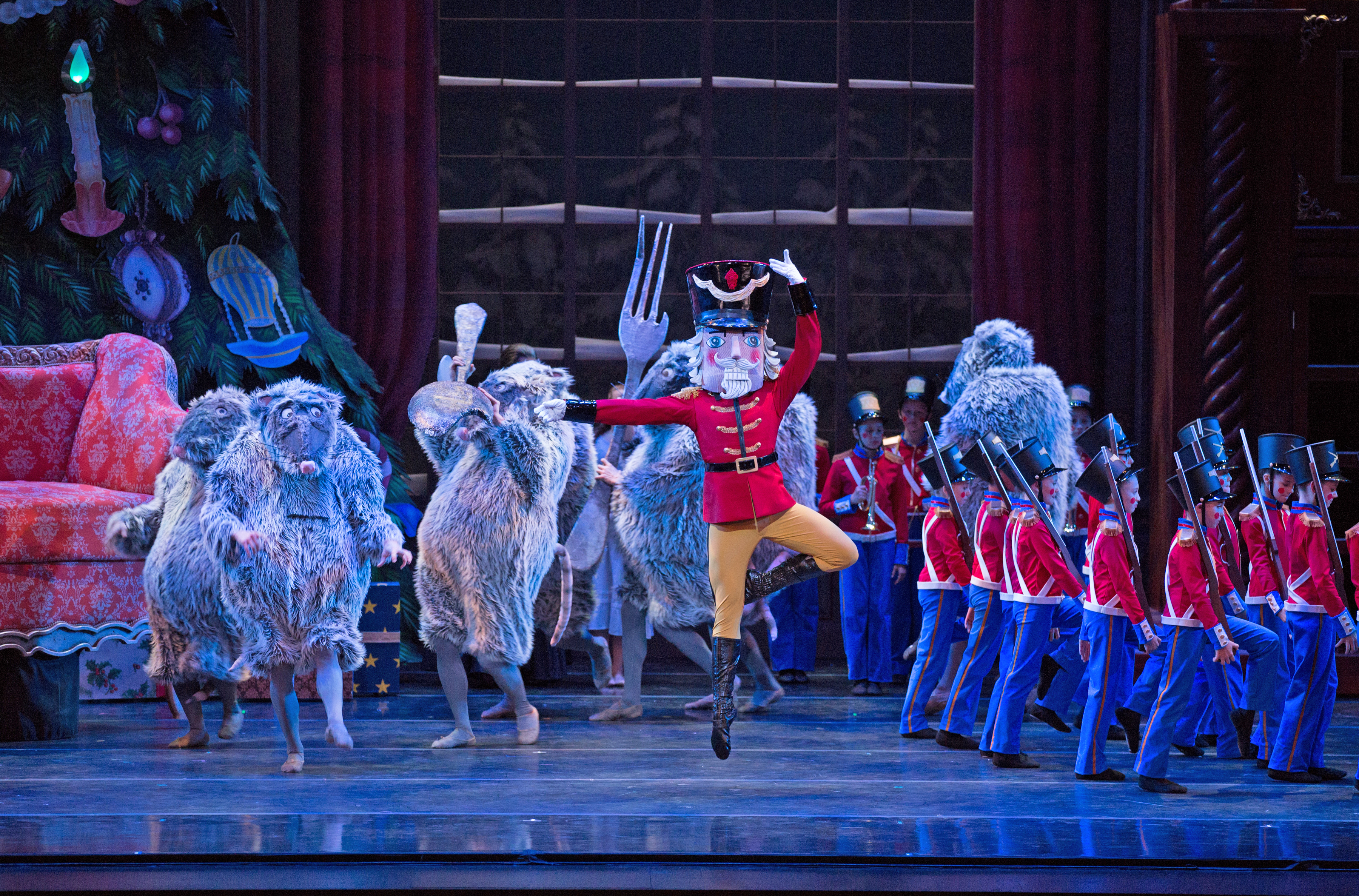IN REVIEW: IBSEN, Verdi & Bach – Weekend offers treats, challenges, oddball moments
The Kansas City Repertory Theatre’s production of Peer Gynt must count as one of the loopier local theatrical experiences in recent memory. A Troll King with three heads, a priest in crimson high heels, a pig puppet on a stick: Director David Schweizer has taken Ibsen’s massive play and condensed it into two hours of zany antics—with lavishly whimsical scenic designs by David Zinn—and although he has retained much of the essence of the playwright’s epic vision he has traced a non-linear chronology that is, ultimately, rather unsettling. Three actors play Peer, each representing a different aspect of this Candide-like character: the brusque innocent, the savvy middle-aged businessman, the puzzled philosopher. Beginning with an onion metaphor (“it’s all just layers … that’s nature’s joke”), we gradually see Peer’s character “peeled away” until we’re not sure that there is anything left.
Danny Gavigan is winning as the young Peer, his brashness setting the stage for trouble to come. Birgit Huppuch plays both Ase (Peer’s brassy mother) and Solveig (the gentle, steadfast love of his life), which raises perhaps unwarranted Freudian overtones. Evan Zes is hilarious in the hyperactive physical comedy throughout, which he plays both as Peer and as Mads Moen, one of his rivals. Luis Moreno is the main “head” of the three-headed Troll King, which he negotiates through an enormous bag-like costume that also holds two other actors. (Costume designs—a mixture of modern dress, Norwegian bucolic and just plain wacky—are by Christina Wright.) Kate Cullen Roberts plays both innocent Ingrid and torchy Anitra. True, Peer goes off on a journey to find the meaning of life, and along the way encounters the Troll King and the Button Maker, makes a fortune and loses it, and is crowned emperor because he solves the riddle of the Sphinx. And it must be said that much of the zaniness draws from the original. (Even Grieg’s celebrated music is heard, before the curtain, in jazzed up versions.) But in the end the production has a sort of ’60s experimentalist feel to it, which partly undermines the play’s larger points of innocence, moral corruption and redemption through love.
Peer Gynt runs through May 22. For tickets call 816-235-2700 or go to www.kcrep.org.
* The Metropolitan Opera’s most recent HD broadcast to multiplex theaters was Verdi’s Il trovatore, and it had strong merits across the cast. David McVicar’s production includes a rotating set design by Charles Edwards which allows the action to move swiftly from scene to scene, allowing this wrenching story to race by in a bracing three hours. Dolora Zajick was utterly gripping as Azucena, the gypsy woman out to avenge her mother’s execution at the stake. Her searing presence set the tone for the whole cast: Vocally she still commands this signature role surprisingly well after some 30 years singing it. Marcelo Álvarez was in charge of the vocal demands of Manrico but tended to overact at times to the point of hamming, which plays to a large house better than it does to the close-ups that the Met’s relentless cameras provide. Sondra Radvanovsky demonstrated breathtaking technique in her potent arias, including an ability to move from fortissimo to pianissimo on a dime—though the voice can sound hard at times, especially in the upper register. Dmitri Hvorostovsky was commanding at the Count de Luna, aptly detached but always imbuing his splendid baritone with inner warmth.
Marco Armiliato’s conducting was swift, unfussy and mostly quite precise, though perhaps not always as imaginative as one would like. Despite the musical and vocal felicities, the production overall had a dreary feel to it. (Granted, it is not a happy story.) For despite the ingenious structure of the set design, it is drab, crumbling and uninviting, and the whole opera is played as if practically in the dark. (Why hire the person who is perhaps the world’s most famous lighting designer, Jennifer Tipton, and then not allow her to turn on the lights?) But the bracing sense of being on Met stage, enhanced by well-designed camera work (not to mention hot dogs and a soda) made for a satisfying day at the opera.
Il Trovatore will be encored May 18th at multiplexes around the KC metro area. Go to www.metoperafamily.org and click on HD Live at the bottom of the page.
* Bachathon was a quite a treat this year. The annual five-hour marathon of the master’s works, sponsored by the local chapter of the American Guild of Organists, included fine performances by local organists, choirs and vocal soloists. I was able to attend only from 4 p.m. to the end (7 p.m.), but I found myself wishing I’d heard the first two hours as well (especially the performance byMark Ball’s Village Presbyterian Church Choir and KC Baroque Consortium, which by all accounts gave a fine rendering of Cantata 94, Was frag’ ich). Jonathan Gregoire gave highly musical interpretations to BWV 656 and BWV 622, then accompanied the accomplished Valley View UMC Chancel Choir in Cantata No. 4 (under Patrice Sollenberger’s capable direction). Audience participation was, as always, a part of this Bachathon: What a thrill it is to get to open the hymnal and sing a delicious chorale likeChrist Lay in Death’s Strong Bonds and then, immediately thereafter, listen to Bach’s “take” on the chorale tune.
Ray Smith showed a sophisticated sense of rubato in four chorales including Christ ist erstanden, and David Pickeringdisplayed a sense of humor in Bach’s great D-major Prelude and Fugue, BWV 532. Arnold Epley’s Musica Vocale sounded strong in Cantata 131 (Aus der Tiefen), beautifully accompanied by the KC Baroque Consortium. (Countertenor Jay Cartershowed off his signature stylistic command in his solos.) The best was saved for last: Jan Kraybill demonstrated her extraordinary virtuosity at the keyboard in four chorales and, most famously, the “St. Anne” Fugue. She began the latter at a tempo that seemed downright suicidal, but managed to hack through the thickets of one of Bach’s most complex works with nary a hitch. Her remarkable feat brought the audience to its collective feet.
To reach Paul Horsley, performing arts editor, send email to phorsley@sbcglobal.net.
Features

By Paul Horsley David Ludwig knows better than to attach a “back-story” to a piece irrevocably, although he has openly stated that his new Violin Concerto was inspired by his…

By Paul Horsley Each production of The Nutcracker is to some extent a balancing act between spectacle and dance. At best it seamlessly integrates the colors and stagecraft that keep…

By Paul Horsley The Lyric Opera of Kansas City deserves applause for taking on an opera in Czech for the first time in its history, but the opening performance of…






